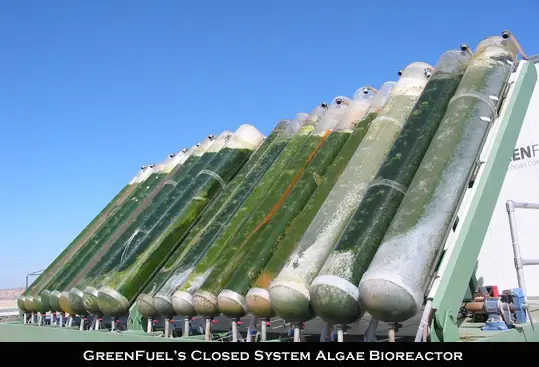Biodiesel From Algae: From 1978 to 1996, the U.S. National Renewable Energy Laboratory experimented with using algae as a biodiesel source in the “Aquatic Species Program”.
A recent paper from Michael Briggs, at the UNH Biodiesel Group, offers estimates for the realistic replacement of all vehicular fuel with biodiesel by utilizing algae that have a natural oil content greater than 50%, which Briggs suggests can be grown on algae ponds at waste water treatment plants. This oil-rich algae can then be extracted from the system and processed into biodiesel, with the dried remainder further reprocessed to create ethanol.
The production of algae to harvest oil for biodiesel has not yet been undertaken on a commercial scale, but feasibility studies have been conducted to arrive at the above yield estimate. Based on results from six years of tests run in parallel in California and Hawaii, 1,000 m2 pond systems were built and tested in Roswell, New Mexico. The Roswell, New Mexico tests proved that outdoor ponds could be run with extremely high efficiency of CO2 utilization. Careful control of pH and other physical conditions for introducing CO2 into the ponds allowed greater than 90% utilization of injected CO2.
Producing biodiesel from algae requires large amounts of CO2 for the algae to be able to photosynthesize. One such source of CO2 is coal fired power plants. Typical coal-fired power plants emit flue gas from their stacks containing up to 13% CO2. This high concentration of CO2 enhances transfer and uptake of CO2 in the ponds. The concept of coupling a coal-fired power plant with an algae farm provides an elegant approach to recycle of the CO2 from coal combustion into a usable liquid fuel.

The cost analyses for large-scale micro algae production evolved from rather superficial analyses in the 1970s to the much more detailed and sophisticated studies conducted during the 1980s. A major conclusion from these analyses is that there is little prospect for any alternatives to the open pond designs, given the low cost requirements associated with fuel production.
The factors that most influence cost are biological, and not engineering-related. On May 11, 2006 the Aqua flow Bionomic Corporation in Marlborough, New Zealand announced that it had produced its first sample of bio-diesel fuel made from algae found in sewage ponds. Unlike previous attempts, the algae was naturally grown in pond discharge from the Marlborough District Council’s sewage treatment works.
PetroSun, through their subsidiary Algae BioFuels is also looking into commercial biodiesel from algae. The good thing about biodiesel produced from algae is that it contains no sulphur, is non-toxic and highly biodegradable.
One of the biggest advantages of biodiesel compared to many other alternative transportation fuels is that it can be used in existing diesel engines, which relieves manufacturers of having to make costly engine modifications. Biodiesel can also be mixed, at any ratio, with conventional petroleum diesel. As a result, the alternative fuel can be used in the current distribution infrastructure, replacing petroleum diesel either wholly, or as a diesel fuel blend with minimal integration costs.
|
BiomassTechnologies
LandfillGas Whatis Biofuel? PalmOil Biodiesel Biodieselfrom Tallow EthanolBiofuel BiofuelEthics Wood Gas Generator
|
